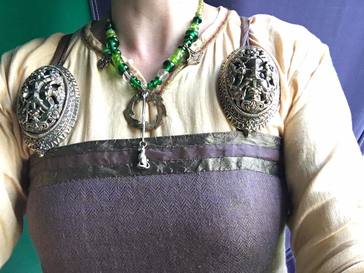
- Fit of the dress: I will always recommend looking at this first. My dresses range from very loose, to somewhat more fitted (mostly due to weight gain, lol). But the top hem of the dress is always fitted against my body (sometimes the whole bust area is fitted as well, but not always). If I slip into the dress, I am in no danger of it falling down before I can get my brooches on. You can easily test this by taking a couple of temporary tucks in the dress, adjusting the length of the straps, and then seeing if you are still having issues.
If the tucks in the dress take care of your issue, you can open up a few seams and take the garment in, or even consider adding some tiny pleats in the front such as we see in the Kostrup dress.
- Fabric: What fabric are your straps made from? What fabric is the dress? In archeological example, we see that often the straps do not match the dress, with linen straps and wool dresses sometimes found. Linen is sturdy and, if it is quality linen, has little stretch. (Some of the colored linen at Joanns, as well as that from some inexpensive vendors, is very short staple, meaning that the linen fibre is chopped up to bits and processed like cotton. This will stretch more than other types of linen and might need some reinforcement.) You can replace the current straps with stronger ones, or add a linen cord or heavier linen or even sturdy silk cloth core to the straps to help eliminate stretch. On the "Viking Clothing (SCA-Style)" Facebook group, Astri Bryde recommends using the selvedge in the straps to help combat stretch. I personally find that suggestion to be brilliant as most modern selvedges tend to be very sturdy.
If the dress itself is stretching (I have one wool dress that is somewhat loosely woven, and it stretches like crazy with heavy brooches), then add a bit of linen to the top of the dress itself inside, or even add a more sturdy tablet woven band or strip of silk to the outside to combat this stretch. (A really stretchy cloth might require you to line the entire bust area with something more sturdy, but take it one step at a time when testing solutions.)
- Build: Everyone is built different. Sometimes sloping shoulders or other things might mean that you need to angle the straps differently on your dresses. You can change this angle by setting the straps closer together in the back than the front and testing that out.
- Are you using short front loops on the dress or are you pinning directly through the fabric of the garment? Using loops allows you to strain your cloth less, and preserve it longer (constantly re-pinning through the cloth itself will both damage and stretch your precious aprondress textiles).
- Construction of straps: There are several ways historically to fold the cloth to create the straps. My personal favorite is to fold the cloth in half lengthwise and press it, and then fold each of those ends in and press again and whip stitch the edge closed. This looks like double fold bias tape, but is not cut on the bias (straps cut on the bias would be very, very stretchy). Also, if you have the option to cut the straps on the grain, rather than across it, that might eliminate some issues.

 RSS Feed
RSS Feed